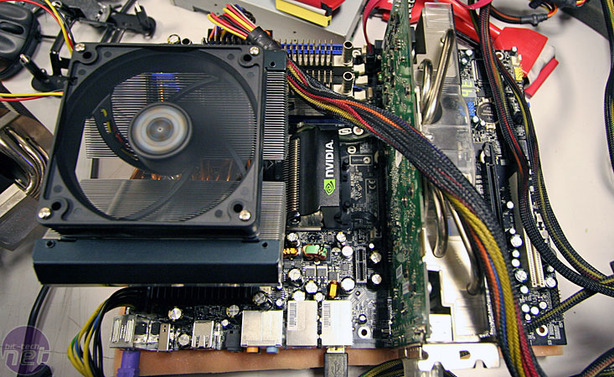Overclocking
Dual-core: It was only back in February when we reviewed the Inno3D nForce 680i SLI motherboard, but there's already been seven revisions of BIOS since then. Back then we got the X6800 on a 6x multiplier all the way up to a huge 487MHz FSB, stable.The P30 on the other hand wouldn't do over 450MHz FSB stable for us, no matter what voltage we used or whether it was a 1333MHz or 1066MHz FSB processor. It's no doubt a good overclock, but not an improvement on our previous result.
Quad-core: With the P23 BIOS, quad-core support is there but 1333MHz FSB processors cause it to hiccup a bit on POST, reporting the bus speed incorrectly. It still works with a QX6850 at the correct speeds, however the overclocking is extremely limited and we couldn't even get it to boot at even a fraction over stock speeds and managed all of 350MHz FSB: just a 17MHz improvement.
So, we tried a QX6700 on a 1066MHz FSB and it made it to roughly 370MHz FSB on both the P30 BIOS EVGA and XFX boards as well as the P23 BIOS Inno3D board. To test it wasn't a CPU limitation we tried it in an Asus Striker Extreme: same chipset, but a custom build and BIOS. It sailed past 400MHz and we eventually managed 430MHz FSB before it croaked. Therefore, the problem certainly isn't a CPU limitation.
We then checked if it wasn't just a "FSB hole" (something nForce 680i SLI boards are famous for) and found that the P30 booted the quad-core just fine when we jumped straight to 400MHz FSB. In the end we got out a very healthy 450MHz stable out of it, and a final bootable bus speed of 462MHz FSB. We tried the "jump over the FSB hole" trick with the P23 and didn't have the same luck, finding it just wouldn't take any value.
So improved quad-core overclocking? Yes, finally there's something to be happy about.
Final Thoughts
There's no doubt that if you want ultimate compatibility for the latest processors and 1333MHz FSB then the latest P30 BIOS is a de-facto upgrade. However, it's disappointing that the performance hasn't shown itself to match the claims in virtually every single test. We used the exact same drivers and hardware on both machines so they are as directly comparable as possible, the only difference is the re-branding, however the fundamental board underneath is still the same.
It's not as if it was limited to one board either, we had newly flashed boards in from both EVGA and XFX and both offered the same out the box, so we are pretty certain it's not a "bad flash" or "bad board". To be perfectly honest, despite the late success with quad-core overclocking, we've had sporadic troubles with this BIOS on both boards.
These ranged from continual boot hanging instead of a "failed overclock reset", to an inability to sometimes reset the CMOS properly and on occasion failing to turn on at all, despite numerous hardware interchanges to find a combination that works. It strangely comes and goes though, for three hours I was tearing my hair out then suddenly everything is hunky-dory again?!
If you're after a bit of Q6600 G0 overclocking with some SLI action, then the P30 will certainly fit the bill, even if it's a touch slower than the older BIOS. However that's probably due to the fact the older BIOS features LinkBoost, and simply overclocking the PCI-Express lanes to 125MHz and HyperTransport to 250MHz will cure that insufficiency. I still think the improvements are largely overstated, and let's not forget that dual-core overclocking hasn't improved in our experience but at least something is certainly heading in the right direction.

MSI MPG Velox 100R Chassis Review
October 14 2021 | 15:04









Want to comment? Please log in.